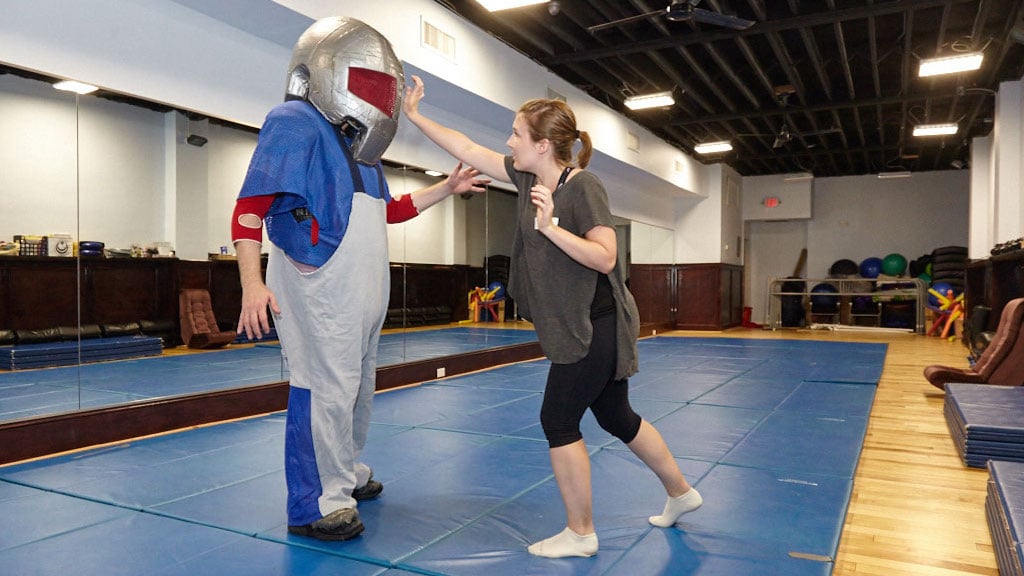When It’s Someone You Know
Women are more likely to be attacked by an acquaintance than by a stranger. Defending yourself against someone you thought you knew can be harder than throwing a punch at a stranger in a dark alley. Here are tips for defending against known attackers.
1. Recognize warning signs
What may start as someone showing up at your workplace uninvited or calling all the time could be a precursor of a relationship that turns abusive. One of the biggest signs, says Lauren Taylor of Defend Yourself, is when the other person “won’t listen to your no. If you set a boundary and the person doesn’t respect it, no matter what the situation, that should be a big red flag.”
2. Speak up
Verbal self-defense can come into play anytime that anyone—a spouse, a colleague, a neighbor—does something that makes you uncomfortable. Taylor suggests that you “attack the behavior, not the person,” telling him exactly what he’s doing that you don’t like. For example, you should say: “You are in my space,” rather than calling him a “freak” or a “perv.”
3. Let no be no
Boundary-setting is about letting the people around you know what you are and aren’t comfortable with. Taylor advises that if you want to say no to someone—for instance, to going home with him—say that without making excuses. And state what you want: “I have to leave now” rather than “Can I leave now?”
4. Try to not escalate the situation
When someone is already mad, the worst thing you can do is fan the flame. If he says, for example, “Are you laughing at me?” don’t argue. “Don’t make them wrong, don’t disrespect them, don’t challenge them, don’t try to control them, don’t threaten them,” says Carol Middleton of DC Impact Self-Defense. Instead, you can counter with questions that distract the person. Say, for instance, “Oh, was I laughing? I must have been thinking of something that happened earlier.”
5. It’s okay to overreact
“Better to overreact and feel like an idiot and go home safe than to think what most people do,” says Middleton. “ ‘I’m just being silly, he’s just a guy.’ ” If you feel uncomfortable, it doesn’t matter if you’re going to hurt someone’s feelings or sound rude.
When It’s a Stranger
Though less common, attacks by strangers do happen. Here are a few tips for pre-venting those.
1. Be mindful on Metro
Although there have been some extreme cases of brutal assaults, and one rape, in the past year on Metro trains, it’s more likely that the kind of crime you would encounter is the theft of your electronic devices. Metro police chief Ronald Pavlik says that sitting in the middle of the train—not by the door, where the robber can grab your phone and be at the escalator before you realize what has happened—is a good way to protect your property.
However, if you board a train and someone is creeping you out, sit in the seat nearest the door, facing in. That way, if the person starts harassing you, you can more easily switch train cars as soon as the doors open.
2. Don’t look like a target
“One of the main things that is preventative in self-defense is that you act very much self-possessed and not like a victim,” says Carol Middleton, who teaches her students to walk with an athletic stride and to look tough, even if they don’t feel like it.
If someone who is coming toward you makes you feel uneasy, you can often thwart a potential confrontation by acknowledging that person as a human being—saying “hey” or “good morning,” for example.
3. Try to not zone out
A number of Pokémon Go–related robberies were reported when the game launched, which shouldn’t be a surprise. Not only are you less aware of your surroundings when you’re absorbed in a screen, talking on your cell phone, or listening through headphones, but those behaviors are also a signal to criminals that you’re a target.
4. Trust your gut
If you’re on the street and something feels weird, duck into a store, strike up a conversation with a friendly-looking person, or get to a more heavily populated place. Don’t ignore your intuition—it’s there for a reason.
5. Ask for help
If someone is harassing you, don’t be afraid to ask a bystander—whether another stranger or a bartender—to intervene and help you end the unwanted encounter.
When Signing Up for Self-Defense
While the classes mentioned in this article are safe bets, if you’re on the hunt for other options, watch out for a few red flags.
1. The “Do This or You’ll Die” Guy
He wants you to think he’s got all the answers and to scare you into listening to him. A good self-defense class will teach you there’s no one-skill-fits-all; it will equip you with a variety of skills—verbal and physical—that you can use according to the situation.
2. The Bully
A self-defense instructor shouldn’t be just as scary as the people you’re training to fight against. If he’s screaming at you, it’s time to leave.
3. The Perfectionist
If he’s furious because you executed a kick the “wrong” way, reconsider the class. When it comes to self-defense, if it works and you get out alive, you’ve done it correctly, even if it wasn’t according to form.
How to Stay Safe . . . for Kids
More than 20 years ago, Irene van der Zande was leading a field trip with a group of seven-year-olds through downtown Santa Cruz, California, when a man approached, screaming that he was going to take one of the little girls as his bride. Motivated by that encounter, van der Zande today runs a nonprofit, Kidpower, which works to arm children with self-defense skills against bullies, abusive relatives, and strangers.
The Virginia Kidpower Center and Chesapeake and Potomac Kidpower Center both accept pupils as young as three, but here are some Kidpower-approved safety skills you can employ with youngsters right now.
1. Let them know you’re never too busy to talk
“We have something called the Kidpower protection promise,” says van der Zande, “which is for adults, at least once a year, to say to every child in their care: ‘You are very important to me, and if you have a safety problem, I want to know. Even if I seem too busy, even if somebody we care about would be upset, even if you made a mistake and did something wrong, even if you promised not to tell, please tell me and I will do everything in my power to help you.’ ”
2. Don’t just tell them what to do—rehearse it
“Kids are literal, so they have to understand how to use their safety skills in different situations,” van der Zande explains. “Parents tend to think safety is a one-time conversation or class. It’s not. It’s like developing the skills for crossing the street. You don’t let them cross that street on their own until they have demonstrated that they can recognize what looks safe and unsafe.”
3. Make a safety plan everywhere you go
“It might be as you’re walking into the store and you say, ‘Let’s make a plan for if we get lost,’ ” van der Zande says. “You should know that kids might not remember [instructions] from two weeks ago.”
4. Don’t worry about feeling awkward
“The safety or well-being of a child is worth causing embarrassment, inconvenience, or offense,” says van der Zande, referencing something Ellen Bass, coauthor of The Courage to Heal, said to her when they were launching Kidpower.
This means that potentially offending the coach who made your child uncomfortable or having to ask your child embarrassing questions is always worth it to keep him or her safe.
This article appears in the November 2016 issue of Washingtonian.




















